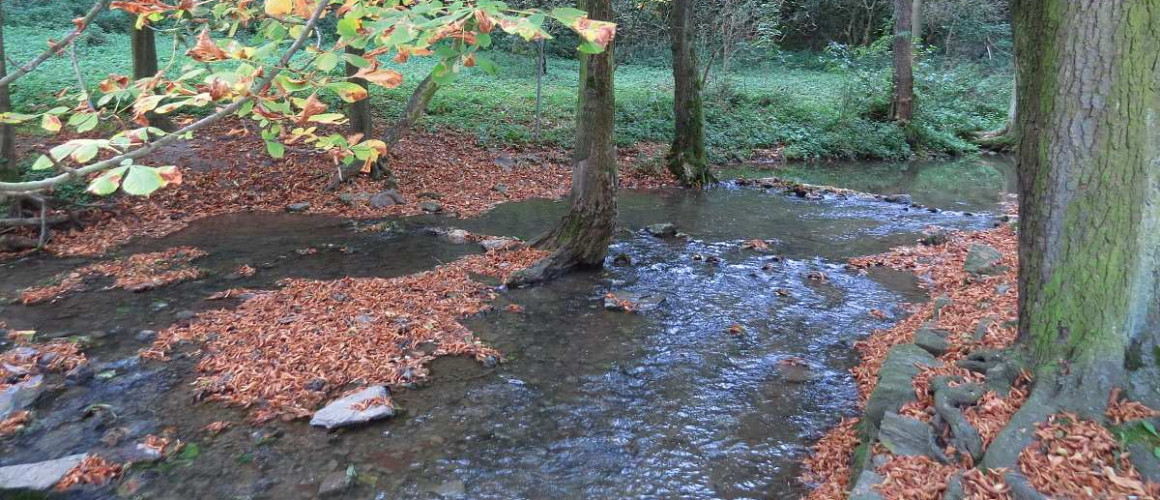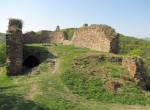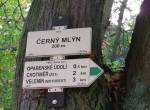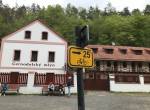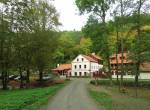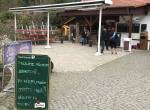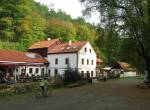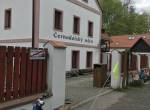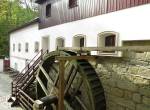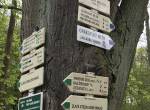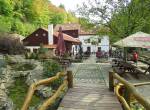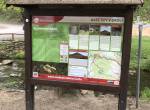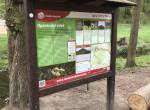Milešovský brook springing at a heigt of 665 m in the lake Březina, flows practically through the whole valley. In several places, the valley widens and creates so-called nine-strong floodplains (flower waterlogged fields). Opárenské valley, with the close Gate of Bohemia, is a unique large area in the Central Bohemian Uplands, where, thanks to the erosion of a watercourse, formed and igneous rocks of various ages are exposed.
The ancient Celts and later the Slavs probably mined quartz porphyry here for the production of millstones. The remains of Oparno Castle, which was built in the 13th century, are above the valley. Climbing on a narrow, steep ridge, the castle must have looked impressive in its times of glory. Today, only the remains of the walls remain. A 275 m long arch bridge leads through the Oparenské valley with a 135 m span of the lower arch as part of the last completed section of the D8 highway, which leads through the Central Bohemian Uplands Protected Landscape Area. It is an exceptional building.
The landscape character of the Oparenské valley impacted by modern human activity - the elegant arch of the two highway bridge, but also the unique atmosphere of the former way of living, which was concentrated mostly around 9 mills, these are: Havelkovův, Černý (also Vavřincův and Pracharovský), Kaiserův (Císařský, Císařův on the maps) and Valnochův mill. Most of the mills date back to the 16th and 17th centuries, some of which have survived to the present day. The already mentioned Opárenský mill is also known as Konradsmühle and Deutschmühle. Older names reveal who its original inhabitants were. The mill is currently sensitively and professionally renovated. It is the property of the TOM Prague Association and serves as a centre of environmental education. Part of the reconstruction was the renewal of the mill drive and the installation of the mill wheel. A dominant feature of the Opárenské valley is the ruin of the Oparno castle on a rock promontory. Oparno Castle was built in the third quarter of the 13th century and it was one of the oldest castles in the region. When it comes to types, the defensive wall even resembles the inner wall of Házmburk. The castle had an important location near the road from Prague to East Saxony. A path led around the walls, which led to the northern part of the castle protected by a moat, where there is a now unpreserved tower.
INTERESTING FACTS:
The black stork
As silent observers of nature, we can see a black stork on a walk (hunting) quite often at Císař's mill in the Oparenské valley which is one of our most beautifully colored birds. His head, neck and the entire upper side of his body are glossy black, and when viewed closely, this black creates rainbow reflections. From below it is white and the legs, beak and skin around the eyes are markedly red. The stork nests hidden in the branches of trees and moves quietly during the hunt. It is covered by a wall of bushes around the stream, or on the edge of meadows, so only a few people notice it. Soon after the arrival of the storks, usually in April, eggs appear in the nest. Both parents warm them up, and after a month, white chicks with yellow beaks hatch from the eggs. Voices resembling a whistling baby duck will soon be heard. Taking care of the chicks in the nest takes more than two months. Their parents tirelessly bring them fish, amphibians and other food. At the end of the summer, the storks set out for the wintering grounds, which lie in the belt between the southern edge of the Sahara and the Equator. At the same time, the young storks fly to wintering grounds independently and also adult birds, which have nested together, can go to different wintering grounds in completely different directions. Storks usually fly 100 to 300 kilometres a day. Their flight routes may change from year to year, but storks are faithful to their wintering grounds and nesting grounds - they return to the same place every year.
Plaque stone
With the terrain of a double cross, the slab was probably moved here from the original location of the plague cemetery as a memorial to the victims of the plague epidemic in 1680. The stone was previously located about 200 m downstream and its inclined position resembled the plague shaft slab, which it probably is. In 2012, it was reconstructed and moved opposite the Emperor's Mill.
Millstones
The so-called millstones made of quartz porphyry originating from the vicinity of Malé Žernoseky - Oparenské valley, were exported as finished mills and their semi-finished products. From here, millstones were supplied to Celtic settlements in the Krušné Mountains and the large towns of Stradonice, Závist and Hrazany. The largest distance over which they were distributed is about 120 km as the crow flies. You can try a small hand grinder when visiting the ecological centre of the TOM Association in Konrádov mill. It took about 3 hours to grind about 1 kg of flour in that type of a grinder.
Contact
Address
Černodolský mlýn a Oparenské údolí
Phone Contact
+420 602 145 680
Email
info@cernodolskymlyn.cz
Website
www.cernodolskymlyn.cz

